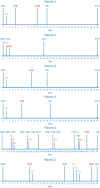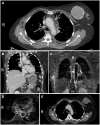Granulocyte colony-stimulating factor- and chemotherapy-induced large-vessel vasculitis: six patient cases and a systematic literature review
- PMID: 32128475
- PMCID: PMC7046168
- DOI: 10.1093/rap/rkaa004
Granulocyte colony-stimulating factor- and chemotherapy-induced large-vessel vasculitis: six patient cases and a systematic literature review
Abstract
Objective: Patients receiving chemotherapy are prone to neutropoenic infections, presenting with non-specific symptoms such as a high fever and elevated inflammatory parameters. Large-vessel vasculitis (LVV) may have a similar clinical presentation and should be included in differential diagnostics. A few published case reports and adverse event reports suggest a causal association between LVV and the use of granulocyte colony-stimulating factor (G-CSF) and chemotherapy. Our objective was to evaluate the relationship between LVV, G-CSF and chemotherapy.
Methods: Between 2016 and 2018, we identified six patients in Finland with probable drug-induced LVV associated with G-CSF and chemotherapy. All six patients had breast cancer. A systematic literature review was performed according to PRISMA guidelines using comprehensive search terms for cancer, chemotherapy, G-CSF and LVV.
Results: The literature search identified 18 similar published case reports, of which most were published after 2014. In all patients combined (n = 24), the time delay from the last drug administration to the LVV symptoms was on average 5 days with G-CSF (range = 1-8 days) and 9 days with chemotherapy (range = 1-21 days). Common symptoms were fever (88%), neck pain (50%) and chest pain (42%). Based on imaging, 17/24 (71%) had vascular inflammation in the thoracic aorta and supra-aortic vessels, but 5/24 (21%) reportedly had inflammation limited to the carotid area.
Conclusion: This review suggests that LVV may be a possible serious adverse event associated with G-CSF and chemotherapy. Successful management of drug-induced LVV requires early identification, through diagnostic imaging, and discontinuation of the drug.
Keywords: adverse drug reaction; aortitis; chemotherapy; febrile neutropoenia; granulocyte colony-stimulating factor; large vessel vasculitis; vasculitis.
© The Author(s) 2020. Published by Oxford University Press on behalf of the British Society for Rheumatology.
Figures



References
-
- Jennette JC, Falk RJ, Bacon PA. et al. 2012 revised International Chapel Hill Consensus Conference Nomenclature of Vasculitides. Arthritis Rheum 2013;65:1–11. - PubMed
-
- Weyand CM, Goronzy JJ.. Giant-cell arteritis and polymyalgia rheumatica. N Engl J Med 2014;371:1652–3. - PubMed
-
- Muratore F, Crescentini F, Spaggiari L. et al. Aortic dilatation in patients with large vessel vasculitis: a longitudinal case control study using PET/CT. Semin Arthritis Rheum 2019;48:1074–82. - PubMed
-
- Stanbro M, Gray BH, Kellicut DC.. Carotidynia: revisiting an unfamiliar entity. Ann Vasc Surg 2011;25:1144–53. - PubMed
-
- Michailidou D, Rosenblum JS, Rimland CA. et al. Clinical symptoms and associated vascular imaging findings in Takayasu’s arteritis compared to giant cell arteritis. Ann Rheum Dis 2020;79:262–7. - PubMed
LinkOut - more resources
Full Text Sources
